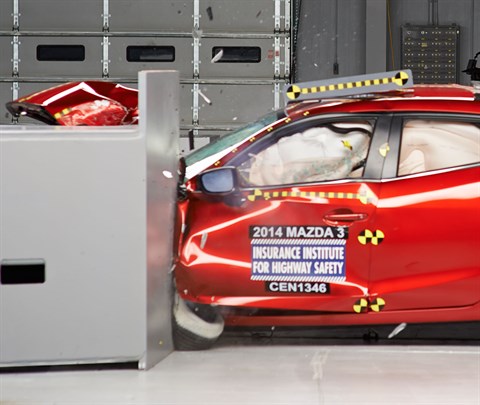Small overlap front: driver-side
Rating applies to 2014-18 models built after October 2013
Tested vehicle: 2014 Mazda 3 i-Touring 4-door
The Mazda 3 was redesigned for the 2014 model year. Beginning with 2014 models built after October 2013, the front suspension was modified to improve occupant protection in small overlap frontal crashes. (Information about when a specific vehicle was manufactured is on the certification label typically affixed to the car on the driver door or adjacent B-pillar.) The small overlap frontal ratings apply to both the hatchback and sedan versions of the Mazda 3.
| Evaluation criteria | Rating |
|---|---|
| Structure and safety cage | |
| Driver injury measures | |
| Head/neck | |
| Chest | |
| Hip/thigh | |
| Lower leg/foot | |
| Driver restraints and dummy kinematics | |

Action shot taken during the small overlap frontal crash test.

The dummy's position in relation to the door frame, steering wheel, and instrument panel after the crash test indicates that the driver's survival space was maintained well.

The frontal and side curtain airbags worked well together to keep the head from coming close to any stiff structure or outside objects that could cause injury.

Forces on the right lower leg were just high enough to indicate a moderate risk of injury.
Moderate overlap front: original test
Rating applies to 2014-18 models
Tested vehicle: 2014 Mazda 3 i-Touring 4-door
The Mazda 3 was redesigned for the 2014 model year. Moderate overlap frontal ratings are assigned by the Institute based on a test conducted by Mazda. These ratings apply to both the sedan and hatchback versions of the Mazda 3.
| Evaluation criteria | Rating |
|---|---|
| Overall evaluation | |
| Structure and safety cage | |
| Driver injury measures | |
| Head/neck | |
| Chest | |
| Leg/foot, left | |
| Leg/foot, right | |
| Driver restraints and dummy kinematics | |
Side: original test
Rating applies to 2014-18 models
Tested vehicle: 2014 Mazda 3 i-Touring 4-door with standard front and rear head curtain airbags and standard front seat-mounted torso airbags
The Mazda 3 was redesigned for the 2014 model year. Side ratings are assigned by the Institute based on a test conducted by Mazda. These ratings apply to both the sedan and hatchback versions of the Mazda 3.
| Evaluation criteria | Rating |
|---|---|
| Overall evaluation | |
| Structure and safety cage | |
| Driver injury measures | |
| Head/neck | |
| Torso | |
| Pelvis/leg | |
| Driver head protection | |
| Rear passenger injury measures | |
| Head/neck | |
| Torso | |
| Pelvis/leg | |
| Rear passenger head protection | |
Roof strength
Rating applies to 2014-18 models
Tested vehicle: 2014 Mazda 3 i Touring 4-door
Rating applies to both the Mazda 3 hatchback (tested) and the structurally similar Mazda 3 sedan.
| Overall evaluation | |
|---|---|
| Curb weight | 2,866 lbs |
| Peak force | 18,217 lbs |
| Strength-to-weight ratio | 6.36 |
Head restraints & seats
Seat type: Manual cloth seat
| Overall evaluation | |
|---|---|
| Dynamic rating | |
| Seat/head restraint geometry |
About the head restraint & seat test
Currently, IIHS tests apply only to front seats.
Front crash prevention: vehicle-to-vehicle
Child seat anchors
Rating applies to 2015-18 models
| Evaluation criteria | Rating |
|---|---|
| Overall evaluation | |
| Vehicle trim | i Touring |
| Seat type | cloth |
This vehicle has 2 rear seating positions with complete child seat attachment (LATCH) hardware.
It has 1 additional seating position with a tether anchor and the ability to borrow lower anchors from the other seating positions.
Note: When anchors are borrowed, they aren't available to use in their designated positions.
| Evaluation criteria | Rating |
|---|---|
| Overall evaluation | |
| Vehicle trim | i Touring |
| Seat type | cloth |
| Rating icon | Rating |
|---|---|
| G | Good |
| A | Acceptable |
| M | Marginal |
| P | Poor |
| Seating positions that rely on borrowed lower anchors or have only a tether anchor available are not rated. | |
thether anchor symbol | Tether anchor |
lower anchor symbol | Lower anchors |
| Lower anchor(s) can be borrowed from adjacent positions(s) | |
| No hardware available |
Details by seating position
| Position | Rating |
|---|---|
| 1 | |
| Tether anchor | |
| easy-to-find location | |
| no other hardware could be confused for anchor | |
| Lower anchors | |
| too deep in seat | |
| not too much force needed to attach | |
| easy to maneuver around anchors | |
| 2 | |
| Tether anchor | |
| easy-to-find location | |
| no other hardware could be confused for anchor | |
| Lower anchors | |
| Can be borrowed from 1 and 3 | |
| 3 | |
| Tether anchor | |
| easy-to-find location | |
| no other hardware could be confused for anchor | |
| Lower anchors | |
| too deep in seat | |
| not too much force needed to attach | |
| easy to maneuver around anchors |
